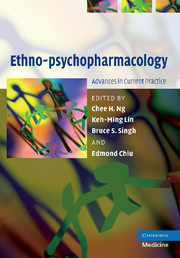Book contents
- Frontmatter
- Contents
- List of figures
- List of tables
- List of contributors
- Foreword
- Acknowledgments
- 1 Introduction
- 2 Culture and psychopathology
- 3 Culture and ethnicity in psychopharmacotherapy
- 4 Ethnic differences in psychotropic drug response and pharmacokinetics
- 5 Pharmacogenetics of ethnic populations
- 6 Variation in psychotropic responses in the Chinese population
- 7 Variation in psychotropic responses in the Hispanic population
- 8 Identifying inter-ethnic variations in psychotropic response in African Americans and other ethnic minorities
- 9 Complementary medicines in mental disorders
- 10 Cultural factors and the use of psychotropic medications
- 11 Outpatient prescribing practices in Asian countries
- 12 Psychiatric inpatient psychotropic prescribing in East Asia
- 13 Pharmaco-economic implications for Asia and other economically disadvantaged countries
- 14 Integrating theory, practice and economics in psychopharmacology
- 15 Research directions in ethno-psychopharmacology
- Index
- References
9 - Complementary medicines in mental disorders
Published online by Cambridge University Press: 22 August 2009
- Frontmatter
- Contents
- List of figures
- List of tables
- List of contributors
- Foreword
- Acknowledgments
- 1 Introduction
- 2 Culture and psychopathology
- 3 Culture and ethnicity in psychopharmacotherapy
- 4 Ethnic differences in psychotropic drug response and pharmacokinetics
- 5 Pharmacogenetics of ethnic populations
- 6 Variation in psychotropic responses in the Chinese population
- 7 Variation in psychotropic responses in the Hispanic population
- 8 Identifying inter-ethnic variations in psychotropic response in African Americans and other ethnic minorities
- 9 Complementary medicines in mental disorders
- 10 Cultural factors and the use of psychotropic medications
- 11 Outpatient prescribing practices in Asian countries
- 12 Psychiatric inpatient psychotropic prescribing in East Asia
- 13 Pharmaco-economic implications for Asia and other economically disadvantaged countries
- 14 Integrating theory, practice and economics in psychopharmacology
- 15 Research directions in ethno-psychopharmacology
- Index
- References
Summary
Modern medicine, called “western medicine” by many non-Western cultures, has taken the leading position in all societies while indigenous medicines either disappear completely or recede to “complementary” status. Indigenous medicine, which was mainstream in the past, is still a principal approach in the management of mental disorders in many cultures. Modern medicine was developed through the exploration of pathology, the deep understanding of dysfunction in certain parts of the body formulated with the knowledge of pathophysiology, pharmacology, molecular biology, genetics, and other medical sciences. On the contrary, almost all complementary medicines rely on the construct of human diseases built on the basis of experience and guided by philosophy. Experience-based medicine applies to a “trial and error” model. The accumulation of successful individual cases leads to the birth of new medication or new therapy. For example, arteannuin was extracted from a plant “Sweet Wormwood Herb” (Artemisiae annuae), which was widely grown in northern-western China. Local people used this plant for the treatment of malaria for hundreds of years and this regimen was recorded in a few of Chinese medical books.
Chinese philosophy believes that each object in this universe is composed of two elements: yin and yang. When yang is stronger, the object reflects characteristics such as warm, bright, positive, and so on, when yin is stronger, it manifests cold, dark, negative properties. However, yin and yang are not consistent nor mutually exclusive. The predominance of yin or yang changes over time due to various environmental or internal factors.
- Type
- Chapter
- Information
- Ethno-psychopharmacologyAdvances in Current Practice, pp. 118 - 122Publisher: Cambridge University PressPrint publication year: 2008



